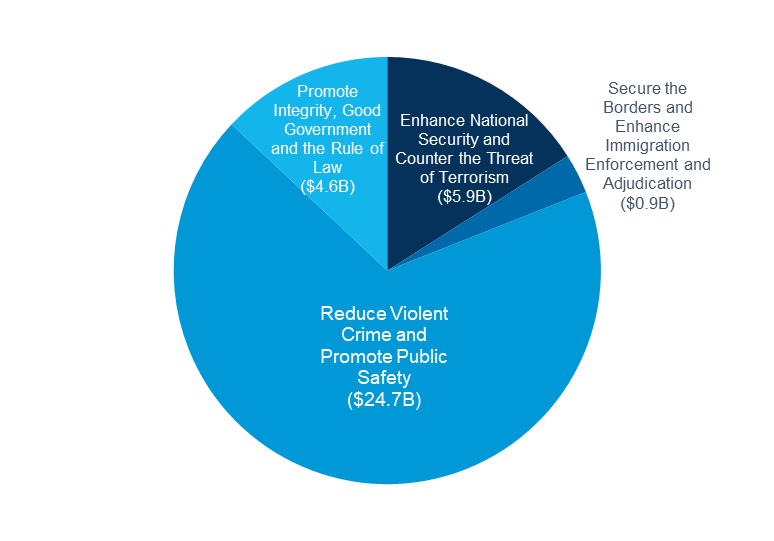IT Modernization and Cyber Initiatives in the DOJ FY 2020 Budget Request
Published: March 20, 2019
BudgetCybersecurityInformation TechnologyDOJ
Sprinkled throughout DOJ’s FY 2020 budget request are increases to cyber programs and IT modernization initiatives across various bureaus.
The FY 2020 budget request for the Department of Justice (DOJ) totals $29.2B, about a 1% decrease from FY 2019 discretionary estimates. Bureaus under DOJ that see the largest increases in FY 2020 from the previous year include USMS (+$354M), DEA (+$343M) and EOIR (+$168M). Meanwhile, BOP saw the largest decrease with $619M less in FY 2020, followed by the FBI with $183M in reductions.
The FY 2020 budget boasts targeted focus in areas of drug enforcement and the opioid crisis, combatting violent crime, immigration law enforcement and national security and cyber. DOJ breaks its budget down according to the goals identified in its FY 2018 – FY 2022 Strategic Plan:

It is under the national security and counterterrorism strategic goal where the budget describes $123M in increases have been provided to further the department’s response to cyber, terrorist and intelligence threats. It appears that a bulk of this increase has been specifically in cyber programs at DOJ’s top bureaus.
- An additional $70.5M to the FBI to develop technical capabilities in implementing its multi-pronged strategy to target criminal actors, nearly a 16% increase over current funds for the program.
- Approximately $11.7M more is requested under the DEA to strengthen the cyber enforcement of teams that combat transnational crime organizations (TCOs) that use cyber to further their criminal ambitions.
Another request for cyber-related increases is at the OIG for an additional $1.7M and six positions for the Cyber Investigation Office to keep up with the request of demands in computer and mobile device forensic examination services.
Likewise, the FY 2020 budget for DOJ is strewn with increases for IT modernization initiatives, particularly targeting the upgrade of outdated systems at ATF.
- More than $4M is requested for the operation and maintenance of the Spartan Case Management System. The new Spartan system replaces the legacy National Field Office Case Information System (NFOCIS) for the agency.
- An additional $3M is provided to fund new IT modernization initiatives to improve the 80% of ATF’s network infrastructure that is outdated and unsupported by manufacturers. Specifically, the increase will be used to help ATF’s ability to respond to critical incidents, decrease backlogs for public requests and support investigations using video surveillance support.
- In order to continue expansion of the National Integrated Ballistics Information Network (NIBIN), $10.7M more is requested for additional NIBIN sites in FY 2020 and to increase the capacity at the National NIBIN Correlation and Training Center (NNCTC).
Moreover, additional funds have been called for to enhance the department’s analytical capabilities including $18.2M more for analytical and technical tools to support the FBI’s transnational organized crime (TOC) program and the Joint Criminal Opioid Darknet Enforcement (J-CODE) platform. Additionally, a $2.5M increase under the department’s OIG is requested to enhance the office’s ability to effectively process datasets pertaining to various transactions at DOJ.
Outside of IT-related enhancements, the DOJ request makes various organizational changes such as requiring alcohol and tobacco enforcement responsibilities under ATF to be transferred to the Department of Treasury’s Tax and Trade Bureau. Furthermore, an additional $254M is to be transferred from the Office of National Drug Control Policy (ONDCP) under the EOP to DEA’s High Intensity Drug Trafficking Areas (HIDTA) program.
Major reductions across the agency include $505M in canceled construction funds previously reserved for a new BOP facility in Letcher County, KY, $244M less for the State Criminal Alien Assistance Program (SCAAP) and $129M in reductions under the COPS Hiring Program.